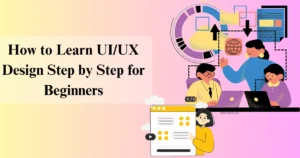If you have ever wondered How to Start a Career in UI/UX Design with No Experience, you are not alone. This fast-growing field is attracting people from all walks of life, including those with no formal background in design or tech. Whether you’re a recent graduate, switching careers, or simply passionate about digital design, this guide is crafted to help you break into UI/UX design from scratch. In this post, you will discover practical steps, helpful tools, and smart strategies that can take you from absolute beginner to a confident designer.

How to Start a Career in UI/UX Design with No Experience
Starting from zero might seem intimidating, but it’s entirely possible to build a successful career in UI/UX design without a traditional background. With consistent effort, a willingness to learn, and the right resources, you can thrive in this creative field. Here’s how:
1. Understand What UI/UX Design Really Means
Before you begin your journey into design, it’s important to clearly understand what UI and UX design are and how they differ.
UI (User Interface) design is centered on the visual components of a digital product, such as colors, buttons, icons, typography, and layout. It focuses on creating visually appealing and consistent interfaces that users can easily interact with.
UX (User Experience) design is about how the product works — how users move through it, how easy it is to use, and how satisfying their experience is. It involves research, wireframing, testing, and improving the user’s journey.
While the two often work closely together, UI is visual and UX is functional. Understanding the difference will help you choose the right path and focus your learning effectively, whether you enjoy creating beautiful designs, solving user problems, or both.
2. Learn UI/UX Design from Scratch
To learn UI/UX design from scratch, begin by exploring beginner-friendly resources that are available online—many of them for free.
- Online Courses: Platforms like Coursera, Udemy, and Skillshare offer structured lessons that cover design basics, tools, and real-world projects.
- YouTube Channels: Learn through free video tutorials from experienced designers like Jesse Showalter, AJ&Smart, and Flux Academy, who break down complex concepts into easy steps.
- Blogs and eBooks: Deepen your understanding by reading from trusted sources like UX Planet, Nielsen Norman Group, and Smashing Magazine.
Create a simple learning plan. Even dedicating just one focused hour per day can help you build a strong foundation over time. Stay consistent, practice regularly, and apply what you learn by creating small projects. This steady approach will help you grow your skills and confidence step by step.
3. Focus on Core Skills and Tools
As a beginner in UI/UX design, it’s important to focus on mastering the fundamental skills and tools that professionals use daily. These form the backbone of your design journey and help you build confidence as you grow.
- Design Tools: Start with one popular design tool like Figma—it’s free and widely used in the industry. You can also explore Adobe XD or Sketch later. Learn how to create wireframes, design interfaces, and collaborate using these tools.
- Wireframing & Prototyping: Practice sketching out app or website ideas and then turn them into digital wireframes. Utilize prototyping tools to make your designs interactive and testable. This helps you understand how screens connect and how users move through a product.
- User Research: Learn how to interview users, create surveys, and analyze data. Effective UX design begins with understanding the user’s needs and pain points.
- Visual Design Basics: Study typography, color theory, spacing, and layout principles. These elements ensure your designs are clean, readable, and visually engaging.
Mastering these core skills through hands-on practice will set a strong foundation for your UI/UX career, even without experience or a design degree.
4. Follow a UI/UX Career Path for Beginners
Following a clear UI UX career path for beginners is one of the smartest ways to avoid confusion and make steady progress. Instead of trying to learn everything at once, focus on practical experiences that help you grow step by step. Start by applying for junior UI/UX designer roles, which are tailored for beginners and provide a great opportunity to learn from senior designers and real projects. These roles often include tasks like creating wireframes, updating user flows, or assisting with research—perfect for building confidence.
If job opportunities seem limited at first, consider freelance work through platforms like Fiverr, Upwork, or Freelancer. These sites allow you to take on small design projects, communicate with clients, and deliver real results. You will learn a lot by doing, even if the pay is low initially. Additionally, volunteering your skills for NGOs, student organizations, or local businesses is another great way to gain experience and build your portfolio.
The key is not to wait for the “perfect” opportunity. Be proactive, practice consistently, and actively seek out opportunities. The more you design, the more confident you will grow. Every project, regardless of its size, brings you closer to becoming a professional UI/UX designer.
5. Build a Beginner Portfolio with No Experience
Your portfolio is your gateway to success, even if you lack professional experience. Start by redesigning existing products, like apps or websites, to improve their user experience and showcase your problem-solving skills. Include case studies to explain your design decisions and process in detail. This showcases your thought process and design methodology. Additionally, work on passion projects based on your interests, such as a travel app or a recipe blog, to highlight your creativity. Focus on showing how you think through design challenges, not just the final product, to create a standout portfolio.
6. Become a UI UX Designer Without a Degree
Yes, you can become a UI UX designer without a degree. Companies now value skills, portfolios, and problem-solving more than diplomas.
- Take part in design challenges (Daily UI, Behance, Dribbble)
- Join online communities (Design Buddies, UX Design Subreddits)
- Attend virtual meetups or webinars to network and learn
Remember, your attitude and skillset matter more than a piece of paper.
7. Master Soft Skills and Communication
UI/UX designers collaborate closely with clients, developers, and stakeholders. This ensures that the design aligns with user needs, business goals, and technical requirements. So:
- Practice explaining your designs clearly
- Take feedback professionally
- Stay curious and open-minded
These soft skills will set you apart in interviews and collaborations.
8. Start Freelancing or Interning Early
One of the quickest ways to gain experience in UI/UX design is by freelancing or interning early in your career. Here’s how you can get started:
- Offer free or low-cost work to local businesses or startups to build your portfolio and gain experience.
- Reach out to startups via LinkedIn or design communities to explore potential opportunities for internships or freelance work.
- Join freelancing platforms like Upwork, Fiverr, and Freelancer.com to find small projects and start building your reputation.
- Start small, as even a single project can open doors to bigger opportunities in the future.
- Develop client communication skills by working on real-world projects, and learn how to manage deadlines and requirements.
- Keep a record of your design process to demonstrate how you tackle challenges and solve problems effectively to potential employers.
Each project, no matter how small, will help you build confidence, enhance your skills, and expand your portfolio, making you more attractive to potential employers.
9. Use Real Tools and Practice Projects
To create a standout portfolio, it’s important to practice using the right design tools effectively.
- Learn Figma, a widely-used tool for creating user interfaces, wireframes, and interactive prototypes. It’s free and ideal for beginners.
- Use Notion or Google Docs to document your design process, user research, and decisions. This helps communicate your thought process clearly.
- Try user testing tools like Maze and Useberry to gather feedback and simulate user interactions with your designs.
- Work on practice projects like redesigning websites or apps, and treat them like real client projects. Ensure your work reflects a professional standard.
- Focus on the process, not just the final design, by showing how you arrived at your design decisions and how they benefit users.
- Receive thoughtful feedback from mentors or peers to refine your skills and take your designs to the next level.

By using industry-standard tools and treating practice projects seriously, you will not only improve your design abilities but also build a portfolio that demonstrates your skills to potential employers.
10. Stay Updated with Industry Trends
The UI/UX world is always evolving. Stay informed by:
- Subscribing to design newsletters
- Following top designers on Twitter, LinkedIn, and Medium
- Trying out new tools and plugins
This will keep your work fresh and competitive.
11. Prepare for Interviews and Job Applications
When applying for jobs:
- Tailor your resume and portfolio to each role
- Prepare to talk about your process and decisions
- Be honest about being a beginner, but show your passion and growth
Confidence and clarity go a long way.
12. Join a Design Mentorship Program
Having a mentor can accelerate your journey. Look for:
- ADPList (free mentorship platform)
- Local or online bootcamps offering mentorship
- UX mentorship groups on Slack or Discord
Learning from real-world designers will fast-track your progress.
13. Turn Your Passion into a Full-Time Job
With consistent growth and effort, you will soon outgrow the beginner stage and be seen as a capable designer. By consistently learning, practicing, and showcasing your work, you will gain the confidence and skill to land real jobs and grow as a professional UI/UX designer.
Conclusion:
A successful career in UI/UX design is within reach, even without a degree or extensive experience. What matters most is your dedication to learning, your passion for design, and your ability to adapt. By taking the right steps, using accessible tools, and consistently building your skills, you can create a strong foundation for your career. Stay curious, remain committed, and embrace every opportunity to grow. Your journey into UI/UX design starts now—take that first step, and watch your career unfold. The path is yours to create.











